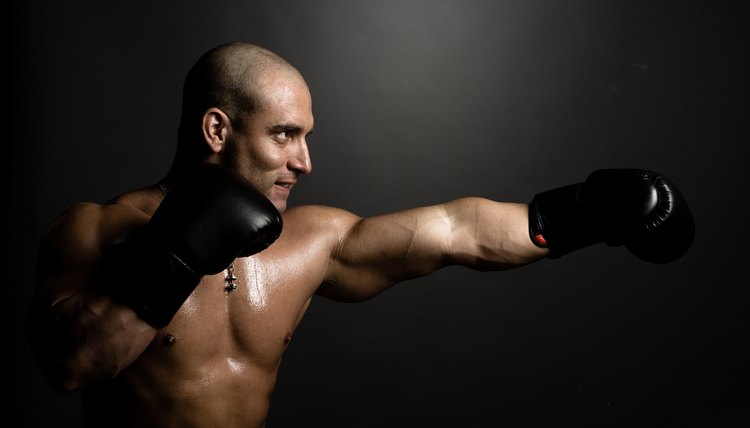Do Boxing Exercises Work the Lats & Biceps?

Boxing is a physical activity that uses all the musculature of your body, from head to toe. Among the main muscles used are the lats and biceps. Lats is an abbreviation for the latissimus dorsi, the largest muscle of the back. As for biceps, it's a simpler way of referring to the biceps brachii, or two-headed muscle of the arm. Learn which boxing exercises work your lats and biceps to the greatest degree.
Lats and Biceps
The latissimus dorsi consists of several muscular segments that extend from the front of your upper arm down to your middle-lower back region. This muscle has many functions, including shoulder adduction and shoulder extension. On the other hand, the two heads of the biceps brachii extend from your shoulders down to your forearms. This muscle group allows you to bend your elbows and flex your shoulders.
Punches
When a boxer throws a punch, be it a jab, cross, hook or uppercut, the power of his punch is generated from the ground up. However, since both the lats and arms attach to your arms, when you swing to throw a punch, these muscles must contract to contribute to the overall power of your punch. The lats are especially involved during the cross and the hook. The cross is sort of a straight power punch that you throw from your dominant side. As for the hook, it is usually thrown from either of your sides and is more of a looping type of punch. The biceps are a little more involved during the jab and uppercut. The jab is often a snapping type of punch, while the uppercut requires that you flex your shoulders to elevate your arm during the punch.
Jumping Rope
Jumping rope is a staple exercise in programs. It is used as a conditioning tool to enhance a boxer's endurance. Your muscles are made of three types of muscle fibers. Those designed for endurance are called the Type I, or slow twitch, fibers. When you jump rope, you work these muscle fibers the most. Part of the jump rope movement involves a motion called shoulder extension -- your lats are one of the main muscles that perform it. This motion occurs as you swing the rope beneath your feet and behind your back. The slow twitch muscle fibers of the latissimus dorsi are thus highly activated during this phase of jumping rope. Your biceps are also worked when you jump rope, as they help stabilize your elbow joints throughout the exercise.
Pullups
Another staple exercise in boxing programs is the pullup. The reason why boxer's include this exercise in their regimens is because it is arguably the No. 1 movement to strengthen the lats. Because the lats play an important role during several punches, it is important that boxer's train this muscle in a direct manner to develop stronger punches. Pullups also work the biceps, albeit to a much lesser extent than the lats.
References
Writer Bio
This article was written by the CareerTrend team, copy edited and fact checked through a multi-point auditing system, in efforts to ensure our readers only receive the best information. To submit your questions or ideas, or to simply learn more about CareerTrend, contact us [here](http://careertrend.com/about-us).
